Aulos › Aurelian › Fashion & Dress in Ancient Egypt » Origins and History
Articles and Definitions › Contents
- Aulos › Origins
- Aurelian › Who Was
- Fashion & Dress in Ancient Egypt › Origins
Ancient civilizations › Historical places, and their characters
Aulos › Origins
Definition and Origins
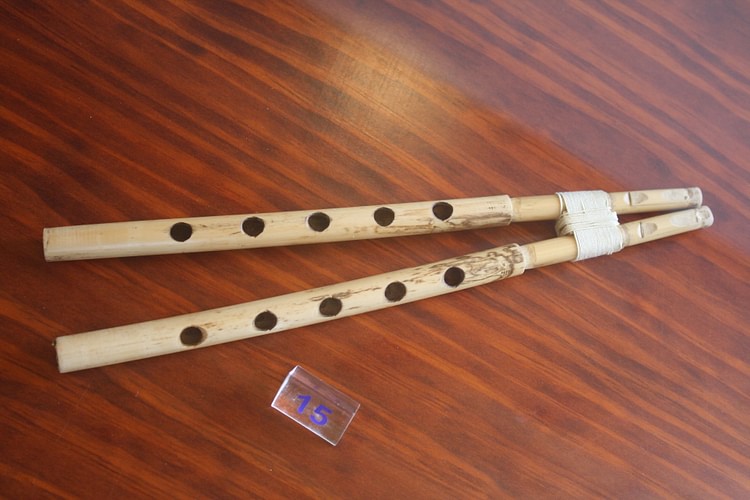
The aulos was a musical wind instrument played by the ancient Greeks. It was also known as the kalamos or libykos lotos, which referred to the material from which part of the instrument was made: respectively, the reed and the Libyan lotus plant.Perhaps the most commonly played instrument, the aulos was played in festivals, processions of births and deaths, athletic games - for the athletes to keep their exercises in rhythm, social occasions, and performances of tragedy in the theatre. It was associated with the god Dionysos and often played at private drinking parties.
Made from cane, boxwood, bone, ivory or occasionally metals such as bronze and copper, the circular pipe ( bombyke ) was fitted with one, two or three bulbous mouth pieces which gave the instrument a different pitch. The pipe itself could be composed of up to five closely inter-locking sections. Sound was produced by blowing and vibrating the single or double reed ( glottides ) within the mouthpiece. Seven holes ( tremata ) were cut down the length of the pipe with sometimes an additional hole to produce another octave of notes. Tonality could be adjusted through the turning of bronze rings between the mouthpiece and the pipe. Frequently, two auloi were fitted together ( diaulos ) at the mouthpiece to produce a richer sound or double melody. The sound produced by an aulete (player) was rhythmical and penetrating and he often accompanied a male chorus.
THE SOUND PRODUCED BY AN AULETE (PLAYER) WAS RHYTHMICAL AND PENETRATING AND HE OFTEN ACCOMPANIED A MALE CHORUS.
Aulos players from Thebes (c. 400 BCE) are credited with inventing rings and keys ( pronomos ) made from silver and bronze which could open or close various holes on the instrument, functioning much like keys on modern wind instruments such as the clarinet.
The earliest surviving examples of auloi have been found at Koilada, Thessaly and date from the Neolithic period (c. 5000 BCE). These instruments are carved from bone and have five holes, irregularly placed down their length. A complete double aulos in bone with tonal bronze rings survives from 4th century BCE Thessaloniki and many fragmentary pieces have been excavated on Delos where there is also evidence of a workshop. The earliest representations in art come from small marble statues from Keros in the Cycladic islands (2700-2300 BCE). Aulos players, both male and female, are commonly depicted on Attic red- and black-figure vases from the 7th century BCE and include depictions of Hercules and Satyrs playing the instrument. Decorated pottery also, on occasion, depicts the leather strap ( phorbeia ) which held the instrument in position over the mouth and even the instrument case ( sybene ) over the shoulder of the player.
Aurelian › Who Was
Definition and Origins
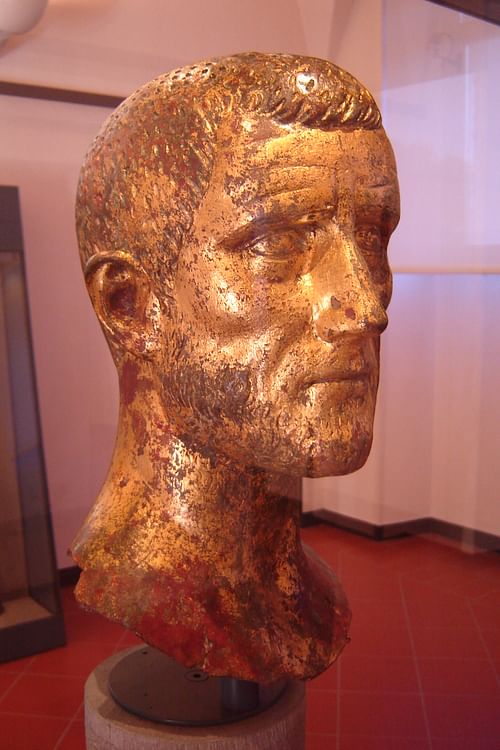
Lucius Domitius Aurelianus (214 or 215 CE - 275 CE) was Emperor of the Roman Empire from 270 - 275 CE. He was born 9 September 214/215 CE in either Serdica or Sirmium in the province of Moesia (later Dacia Ripensis). We know little of his early life, except that he was of modest origins, his father being a colonus to a senator named Aurelius. He had a successful career during the reign of Gallienus, but despite a flourishing career under that emperor, Aurelian nevertheless was part of the conspiracy that eventually assassinated him. With the accession of the usurper Claudius II immediately thereafter, Aurelian was made commander of the cavalry ( dux equitium ). Despite successes against the various barbarian invaders such as the Goths, Vandals, and Juthungi on the Danube frontier, Claudius' reign was cut short when he succumbed to plague which had broken out in 270 CE. Initially, Claudius' brother Quintillus succeeded as emperor, but he seems to have only reigned for a few months. Aurelian soon rose as a rival to Quintillus and when the former was hailed emperor by the troops, he disposed of his rival (September or November 270 CE).
AURELIAN'S EARLY REIGN
Once emperor, Aurelian immediately seized control of the Imperial mint at Sisica (in modern Croatia), striking gold coins there in order to distribute as donatives to his soldiers and thus guarantee their loyalty. He then turned his attention to the wars with the Juthungi and the Vandals which had not yet been finished by Claudius II. With respect to the Juthungi, this tribe had successfully invaded Italy and, having plundered the north of it, were heading home with their booty, the weight of it making their return to their lands much slower. According to the fragments of the third century historian Dexippus, after Aurelian caught up with them, they promised him the contribution of 40,000 of their horsemen as well as 80,000 soldiers to serve in the Roman army. The emperor next turned his attention to the Vandals in Pannonia. After locating their main army, rather than directly attack them, Aurelian initiated a scorched earth policy around them, thus denying them access to food. This tactic worked, and the Vandals soon sued for peace, promising Aurelian the service of 2,000 of their cavalrymen before receiving food from the Romans so that they would not starve on their return home.
IN ROME, AURELIAN DID HIS BEST TO WIN THE SUPPORT OF THE PEOPLE, CANCELLING DEBTS TO THE TREASURY AND MAKING A PUBLIC BONFIRE OF THE RELEVANT RECORDS.
With these matters resolved and an ephemeral peace restored, Aurelian travelled to Rome. Upon arriving in the city, he had to address the immediate problem of a revolt in the city by the workers of the Imperial mint. In the events leading up to this, it seems that the workers at the mint, in the emperor's absence, had developed an overconfident sense of independence that had crossed over the line to insubordination. Such behaviour led to corruption amongst the workers, who it seems were lining their pockets with imperial coin. What led to the revolt, however, is a subject of debate. It has been supposed that Aurelian's efforts to address the currency issue early in his reign may have made the mint workers uneasy: The prospect of an emperor known for instilling discipline and his possible curiosity at any illegal or corrupt activity may have moved the workers to revolt.Another possible cause for the revolt might have lain in the fact that its leader, the rationalis (chief fiscal officer) Felicissimus, may have been the tool of senatorial and equestrian interests who felt threatened by Aurelian's rule. In any case, the revolt lasted only a very short time before it was crushed by Aurelian, who then closed the Rome mint. Other domestic threats to Aurelian's rule included four separate attempts at usurpation by Septiminus (also called Septimius), Domitianus, Firmus (in Egypt during the Palmyrene war, although his existence is contested) and Urbanus, which were quickly found out and crushed.
While at Rome, Aurelian did his best to win the support of the people, cancelling debts to the Treasury and making a public bonfire of the relevant records. This populist strain, according to the historian Ammianus Marcellinus, led him to descend on the rich 'like a torrent' and tax them punitively. The Senate was wary of the soldier-emperor but, realizing that little could be done to resist him, conferred its approval upon him.
DEFENDING THE EMPIRE
In 271 CE, Aurelian found himself having to defend the empire from renewed incursions from the Juthungi, Alamanni, and Marcomanni. Aurelian found what are thought to be Juthungi and Alemannic invaders making incursions into Italy. After thinking he made peace with the Juthungi when meeting them at Milan in 271 CE, that tribe soon went back on their word and surprise attacked the Romans, inflicting a major defeat upon imperial forces. He defeated the invaders in three different places: at Fanum Fortunae, Metaurus, and Ticinus (near modern Pavia). This did not resolve the matter completely, as the invaders would simply regroup and then continue their attacks in other places. The best Aurelian could do was to anticipate enemy movements, find and defeat them in battle, and run the remainder to ground. Aurelian managed to do this, and returned to Rome possibly knowing that his victories had only provided a brief respite.
Upon returning to Rome Aurelian proclaimed a German victory, but was knowledgeable of the fact that this did not allay the fears of the city's inhabitants of a renewed barbarian attack. Meeting with the Senate, the emperor proposed a building of a wall around the city for its defense. Civilian workers were mobilized to perform this task, and a wall was built to defend the city, 21 feet in height, just under 12 miles in extent to defend the parts of the city. He followed this action with a march to the Balkans with his army, defeating Gothic forces in the area and killing Cannabaudes, their leader. Despite this victory, Aurelian realized that the province of Dacia across the Danube was too hard and too expensive to defend, and organized the evacuation of the province's inhabitants back across the river, resettling them in the new province of Dacia Aureliana, partly carved out of the old Moesian province.
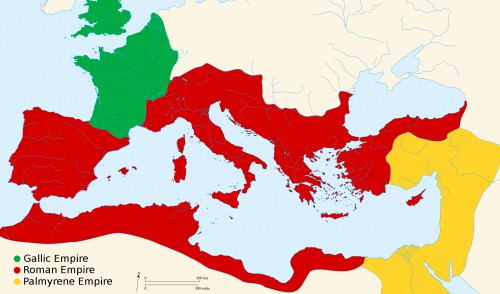
Roman Empire 271 AD
Aurelian's next move was against the breakaway empire of Palmyra that had wrested much of the empire's Eastern possessions away from imperial control and into the hands of Palmyra's queen Zenobia and her underage son Vallabathus.Aurelian began his campaign against Palmyra in 272 CE, and marched through Asia Minor, reclaiming it for Rome and meeting with little resistance. When Aurelian offered mercy to resistant cities such as Tyana and took no reprisals against it once it was recaptured for Rome, word of this conciliatory policy spread to other cities which opened their gates to Aurelian without any resistance whatsoever. Aurelian followed up these peaceful victories with military ones, defeating Zenobia's forces at the battles of Immae and Emesa. Within six months of the beginning of his campaign, Aurelian and his army stood at the gates of Palmyra, which surrendered. Zenobia tried to flee with her son to Sassanid Persia, but they were soon captured and made to walk the streets of Rome in the triumph that Aurelian eventually celebrated. Aurelian marched back westward, defeating the Carpi on the Dabue. Palmyra tried to revolt shortly thereafter, which obliged Aurelian to return east and sack that city in 273 CE. Palmyra never regained the power or influence it previously enjoyed after this time.
After this, Aurelian turned his attention to the breakaway Gallic Empire in the West, which at this time controlled Gallic and British provinces. He defeated these rebels at the battle of Catalunian Fields (Châlons-sur-Marne), causing the Gallic emperor Tetricus to desert his own forces and sue for peace. Aurelian granted Tetricus mercy, and the erstwhile rebel marched with Zenobia in Aurelian's triumph which celebrated the re-integration of the Gallic and Palmyrene empires back into the Romansphere of control. Aurelian proclaimed himself restitutor orbis ('Restorer of the World') to celebrate this occasion.
Aurelian is known for promoting the worship of Invictus Sol ('God of the Unconquered Sun'), creating an official priesthood as well as building a temple to that deity on the Campus Martius with this aim in mind. Although Aurelian did not aim to diminish the role of the traditional Roman state gods in enacting these measures, he hoped to use Invictus Sol as a way of making steps towards a degree of religious unity within the empire.
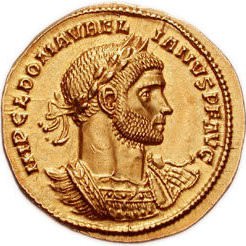
Coin Depicting Roman Emperor Aurelian
By 275 CE, Aurelian was planning a major campaign against Sassanid Persia, perhaps taking advantage of the weak leadership that had come to the Persian throne after the death of Shapur I around 272 CE. Before, he could do this, however, he was assassinated in a household plot at Caenophrurium near the city of Byzantium.
Aurelian has almost universally been described as a ruthless emperor with a predisposition to cruelty (his nickname, manu ad ferrum "hand on hilt" implies that he may have solved problems with a sword rather than words). This portrayal, however, comes into conflict with the fact that he offered mercy on a number of occasions (to the city of Tyana, to Zenobia, to Tetricus) and might imply a bias against him by the historians who wrote about him.
Aurelian's death did much to eliminate existing threats, but it did not end the uncertainty that the empire would experience until 284 CE with the accession of Diocletian.
Fashion & Dress in Ancient Egypt › Origins
Ancient Civilizations
In 1851 CE, a woman named Amelia Bloomer in the United States shocked the establishment by announcing in her publication The Lily that she had adopted the "Turkish Dress" for daily wear and, further, provided readers with instructions to make their own. This "Turkish dress" was a pair of light-weight pants worn under a dress which dispensed with the heavy petticoats and undergarments which constituted women's fashion. At the time of Bloomer's announcement, upper-class women were wearing dresses comprised of as many as 16 petticoats, which were quite heavy, and those of the lower classes were almost equally constrained. These 'Turkish' pants (which came to be known as 'bloomers') emancipated women from the constraints of fashion, allowing them freedom of movement, and became one of the symbols of the new women's suffrage movement.
The Women's Suffrage Movement had only just met to issue their Declaration of Rights and Sentiments, written by Elizabeth Cady Stanton, in 1848 CE at Seneca Falls, NY, and Bloomer's advocacy of the new style was embraced by one of the pivotal figures of the movement, Lucy Stone, who wore the pants during her lectures on women's rights. It was Lucy Stone who would encourage Susan B. Anthony to take up the cause of the women's suffrage movement and Anthony, of course, is now synonymous with women's rights.
All of these challenges to the patriarchy of the 19th century CE were quite disturbing, to women as well as men, but they would have been nothing startling to the ancient Egyptians who viewed women as equals and whose fashion sense was nearly unisex long before that word, or concept, was understood by the more 'advanced' culture of the present day.

Egyptian Couple
Egyptian fashion was practical, simple, and, for most of the population, the same kind of outfit worn by a woman was worn by a man. The upper-class women in the Old Kingdom of Egypt (c. 2613-2181 BCE) wore longer dresses which covered their breasts, but the women of the lower classes would have worn the same simple kilt as their fathers, husbands, and sons.
EARLY DYNASTIC PERIOD & OLD KINGDOM
Images from the Early Dynastic Period in Egypt (c. 3150 - c. 2613 BCE) show men and women of the lower class in the same kind of dress: a knee-length, plain kilt, probably white or light in color. This would have been made of cotton, linen, or byssus (flax) and was fastened around the waist by a belt of cloth, papyrus rope, or leather.
Upper-class Egyptians in the same time period dressed the same only with more ornamentation. Egyptologist Helen Strudwick observes how "only by their jewelry could men from the wealthy class be distinguished from farmers and artisans" (374).Women's dress was more distinctive between classes as upper-class women wore a long, figure-fitting dress with or without sleeves. These dresses were held in place by straps over the shoulders and sometimes were supplemented by a sheer tunic worn over them.
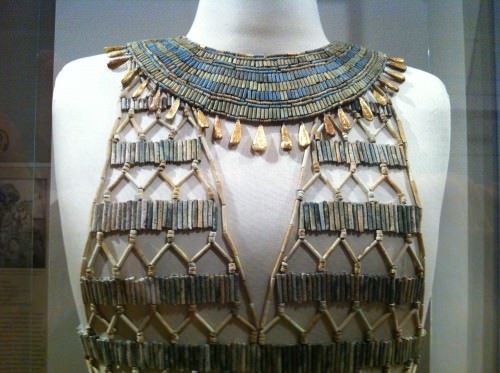
Egyptian Beadnet Dress (Detail)
Women's fashions which bared the breasts were not a matter of concern. The upper-class women's dresses sometimes began below the breasts and went to the ankles. Lower-class women's skirts, as noted, were from the waist to the knees without a top. Before the development of linen, people wore clothes made of animal hide or woven papyrus reeds. Strudwick writes:
Shepherds, ferrymen, and fishermen mainly made do with a simple leather sash from which hung a curtain of reeds; many also worked completely naked, at least until the Middle Kingdom - during this time it became rare to see an unclothed worker. Female millers, bakers, and harvest workers are often depicted in a long wraparound skirt but with the upper part of the body bared. (376)
Children of both sexes wore no clothes from birth until puberty and some occupations, as Strudwick notes, continued this practice. The washermen and washerwomen who worked daily by the banks of the Nile River washing other people's clothing performed their tasks naked because they were in the water so frequently.
FIRST INTERMEDIATE PERIOD & MIDDLE KINGDOM
The First Intermediate Period of Egypt (c. 2181-2040 BCE) followed the collapse of the Old Kingdom and initiated many dramatic changes in the Egyptian culture but fashion remained relatively the same. It is only in the Middle Kingdom of Egypt (2040-1782 BCE) that fashion changes as women begin to wear long cotton gowns and different hairstyles.
MIDDLE KINGDOM DRESSES WOULD BE MADE OF A SINGLE SHEET OF CLOTH WHICH THE WOMAN WOULD WRAP HERSELF IN AND THEN ARRANGE FOR STYLE WITH A BELT AROUND THE WAIST OVER WHICH SHE COULD BLOUSE THE TOP.
In the Old Kingdom and First Intermediate Period women are depicted with hair length just below their ears while, in the Middle Kingdom, their hair is worn to their shoulders. The Middle Kingdom dress of the upper class is also different in that outfits were often made of cotton. These dresses, still form-fitting, were often sleeved with a plunging neckline ornamented with a clasp necklace at the throat. These dresses would be made of a single sheet of cloth which the woman would wrap herself in and then arrange for style with a belt around the waist over which she could blouse the top.
From the same period, however, there is also evidence of upper-class women's dresses which rose from the ankle to the waist and were held up by thin straps which ran over the breasts and were fastened over the shoulders at the back. Men at this time continued to wear the simple kilt only with pleats at the front. Precisely how the ancient Egyptian pleated their clothing is not known, but images in art clearly show pleats in both men and women's clothing. The most popular article of clothing among upper-class men was the triangular apron; a starched, ornamented kilt which fell to just above the knees and was held by a sash. This would have been worn over a loincloth which was a triangular strip of cloth running between the legs and tied at the hips.
THE NEW KINGDOM
Following the Middle Kingdom, Egypt entered the Second Intermediate Period (c. 1782-1570 BCE) during which the foreign people known as the Hyksos ruled from Lower Egypt and the Nubians held the southern frontiers of Upper Egypt with only Thebes in the middle representing Egyptian rule.
The Hyksos gave Egypt many advances, innovations, and inventions which they later made significant use of but do not seem to have contributed to fashion. This is largely because the Hyksos greatly admired Egyptian culture and emulated Egyptian beliefs, behavior, and dress in their cities in the northern Delta.
C. 1570 BCE the Theban prince Ahmose I (c. 1570-1544 BCE) drove the Hyksos out of Egypt and initiated the period of the New Kingdom of Egypt (c. 1570-1069 BCE) which saw the greatest advances in fashion in Egyptian history. The fashion styles of the New Kingdom are those most often depicted in films and television shows dealing with Egypt no matter what time period they are set in.
The New Kingdom was the era of Egypt's empire when the country stepped onto the international stage and came into closer contact with other nations than they had previously. Even before the age of empire, however, fashion statements became more elaborate. Ahmose I's wife, Ahmose-Nefertari (c. 1562-1495 BCE), is depicted in a dress with winged sleeves and a wide collar which falls to above her ankles.
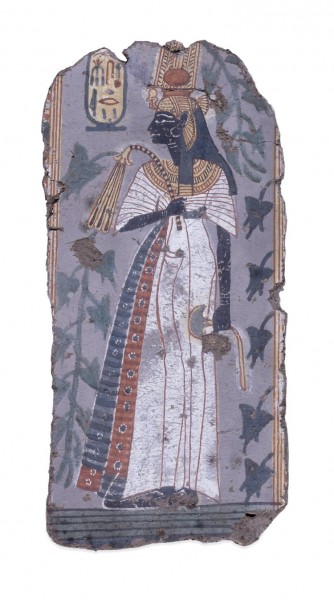
Ahmose-Nefertari
Beaded gowns and dresses (the kalasiris which Herodotus mentions) ornamented with jewels begin to appear in the late Middle Kingdom but become more common in the New Kingdom among the upper classes. Elaborate wigs adorned with beads and jewels also appear with greater frequency at this time. Egyptologist Margaret Bunson notes how "the capelet, made of sheer linen, was the fashion innovation of the New Kingdom" (68). The capelet, or shawl cape, was a rectangle of linen twisted, folded, or cut, and usually attached to an ornamented collar. It was worn over a kalasiris which fell either from the waist or just below the breasts and became the most popular style of the upper classes.
Men's fashion also advanced fairly quickly in the New Kingdom. The kilts of this period drop to below the knee, are more intricately embroidered, and they are often supplemented by a sheer, loose-fitting, blouse. The pharaoh, depicted in the nemes headdress, is often seen in this kind of clothing wearing either sandals or slippers. Bunson notes how men "wore kilts and sheer blouses with elaborately pleated sleeves. Great panels of woven materials hung from the waist and intricate folds were visible under sheer overskirts" (68). This style was popular with the royalty and upper classes who could afford the material.
The lower classes continued to wear the simple kilt, for both sexes, but now more women of the working class appear with covered tops. Previously, Egyptian servants are depicted in tomb paintings and other art as naked or nearly so but, in the New Kingdom, a number of servants are shown not only fully clothed but in fairly elaborate dresses. Strudwick writes:
The clothes worn by the servants of officials and dignitaries were more refined than those of simple folk. A servant depicted in an Eighteenth Dynasty tomb wears a finely pleated linen tunic and loincloth with a wide, pleated sash. (376)
Underwear was also developed further during this period, evolving from the rough, triangular loincloth wrapped between the legs and around the waist to a finer piece of cloth either sewn to a certain waist size or tied at the hips. Upper-class men's fashion in the New Kingdom was this underwear beneath a loincloth over which was worn a long sheer shirt falling to the knees, a broad neck piece (for nobility), bracelets, and sandals. King Tutankhamun (c. 1336-c.1327 BCE) was buried with over 100 of this kind of underwear as well as shirts, jackets, kilts, and cloaks, providing some of the best examples of New Kingdom fashion yet found.
Women's fashion from the period was more elaborate than in any previous era. Men and women of Egypt often shaved their heads to prevent lice and to cut down on the time it would take to maintain a full head of hair. Wigs were used by both sexes to protect the scalp and for ceremonial purposes. The wigs of the New Kingdom are the most ornate, especially for women, and show pleated, fringed, and layered hair styles with a length to the shoulders or below. Sheer gowns of light linen were in favor among the upper-class women, often ornamented with a sash or cape, belted at the waist, and accented by a headpiece, necklace, and earrings.
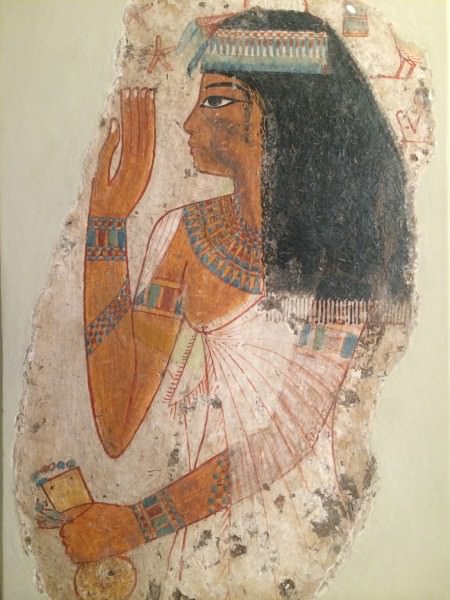
Lady Tjepu
Different professions also adopted fairly consistent styles of fashion. Viziers, for example, wore a long skirt (often embroidered) which fastened under the arms and fell to the ankles along with sandals or slippers. Scribes wore the simple waist-to-knee kilt and are sometimes seen in a sheer blouse. Priests wore white linen robes and, according to Herodotus, could wear no other color as white symbolized purity and the sacred. Soldiers, guards, and police forces also wore the simple kilt with sandals and sometimes wrist guards. Farmers, brewers, tavern keepers, masons, laborers, and merchants are uniformly depicted from this period in the same simple kilt, both male and female, though the merchant sometimes appears in a robe or a cloak. Coats, jackets, and cloaks were common throughout Egypt's history as the temperature at night, and especially in the rainy season, could be quite cold.
FOOTWEAR & ACCESSORIES
Perfume and jewelry were appreciated and worn by both men and women, as were cosmetics. Egyptians of both sexes used kohl under their eyes to decrease sun glare and kyphi, the most popular Egyptian perfume, was regarded so highly it was burned as incense in the temples. Images of Egyptians with cones on their heads are depicting the use of kyphi in its cone form. It was composed of frankincense, myrrh, pine resin, and other ingredients and could be burned (as with the cones), applied to the skin, or used as toothpaste and mouthwash.
Kyphi was most often used by women and applied in very much the same fashion as perfume is in the modern day. A woman, or her maidservant, would open a container of kyphi, fan the air, and walk through the scent. The same is true of cosmetics, which were kept in pots or jars and applied from these containers with a brush or reed, much like the modern eyeliner.
The most popular form of jewelry among the upper classes was gold -based. The Egyptian word for gold was nub, and once the land to the south had been conquered, it came to be called Nubia for the vast amounts of gold found there. All classes of Egyptians wore some kind of jewelry as Strudwick notes:
Virtually every form of jewelry has been recorded, including finger rings, anklets, armlets, girdles and pectorals, necklasces, torques, chokers, diadems, ear studs, earrings, and hair ornaments. Colored semi-precious stones, such as cornelian, turquoise, feldspar, green and red jasper, amethyst, quarts, agate, and lapis lazuli were the most commonly used stones. Often, however, they were imitated by coloured glass and faience. (386)
Footwear was practically non-existent among the lower classes, but in cold weather or rough terrain, they seem to have wrapped their feet in rags. Among the upper classes sandals and slippers were worn but, like the lower classes, people usually went barefoot. Sandals were made of wood, papyrus, leather, or a combination of these and were fairly expensive.Tutankhamun's tomb contained 93 pairs of sandals in different styles and one even of gold. Slippers were made of papyrus rushes woven together but could be supplemented with cloth interiors.
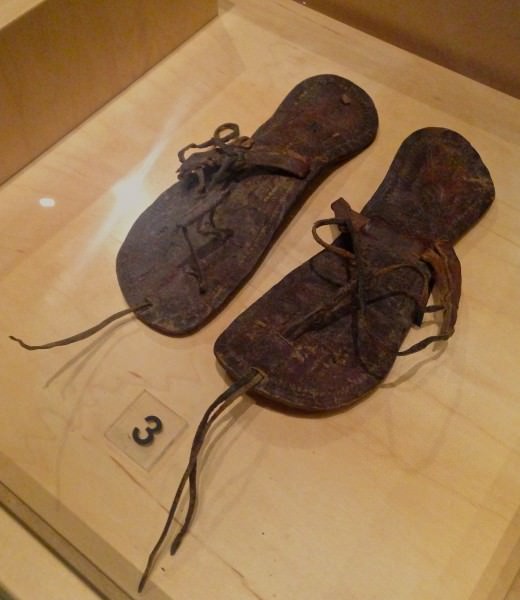
Ancient Egyptian Sandal
There is some evidence of shoes being worn by nobility in the New Kingdom and also the use of silk but this is rare. The Hittites had developed the shoe and the boot by this time, so it would not be surprising to see their appearance in Egypt. In 1258 BCE the Hittites and Egyptians signed the world's first peace treaty, and afterwards cultural diffusion was common between the two. Still, the shoe never became popular footwear in Egypt as it would probably have been considered unnecessary effort; after all, even the gods went barefoot.
MANUFACTURE & SIMPLICITY OF FORM
The earliest clothing was probably papyrus reeds and animal skins, but this changed with the cultivation of flax which was processed and turned into cloth. Women were the first cultivators of flax and initiated the manufacture of clothing. Evidence for this claim is the oldest depictions of textile production showing women at work, not men, and women continuing in textile production even when the industry was run by males. This is not at all unusual as women were the first brewers in Egypt and, most likely, the first healers who predated the rise of the medical profession.
Making clothing began in the home but soon turned into an industry once linen, and later cotton, became popular. Flax fibers were spun into thread and woven on a horizontal loom to create one long piece of cloth, which then was cut. Even the most elaborate dresses and kilts were simply a bolt from this cloth which was rarely sewn into any shape. The kalasiris was little more than a sheet a woman wrapped around her body; the individual turned that sheet into a dress through personal skill in manipulating the cloth.
Simplicity was the central value of Egyptian fashion even when styles became more elaborate in the New Kingdom. The basic concept of Egyptian fashion also did not change much from the time of the Old Kingdom through the Ptolemaic Dynasty (323-30 BCE) which was the last dynasty to rule Egypt before it was annexed by Rome. The kinds of fashion one sees in this later period are very close to those from the New Kingdom which follow the basic form of Old Kingdom dress. It may safely be said that more radical changes have taken place in fashion in the last 150 years than in the whole span of Egyptian history, but this is only because the ancient Egyptians understood that simplicity of style can often be the most elegant and certainly the most classic.
LICENSE
Article based on information obtained from these sources:with permission from the Website Ancient History Encyclopedia
Content is available under License Creative Commons: Attribution-NonCommercial-ShareAlike 3.0 Unported. CC-BY-NC-SA License